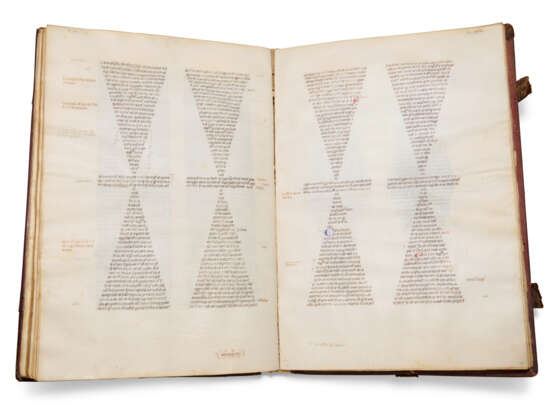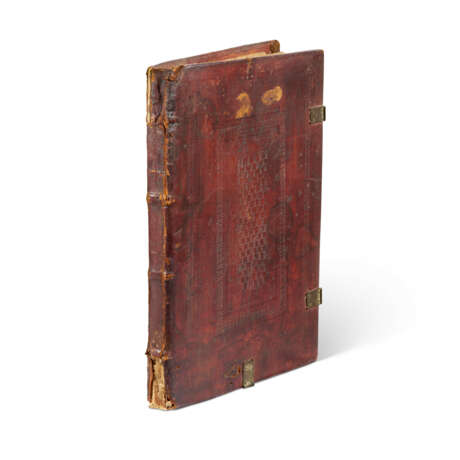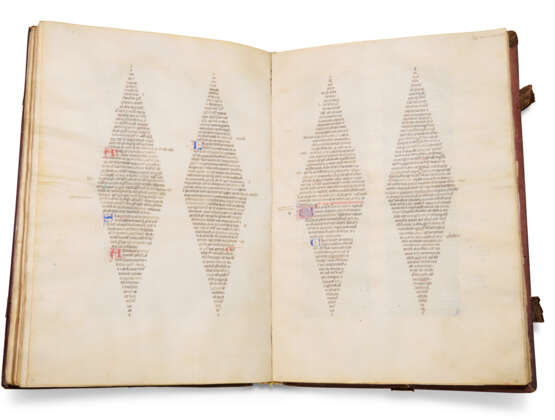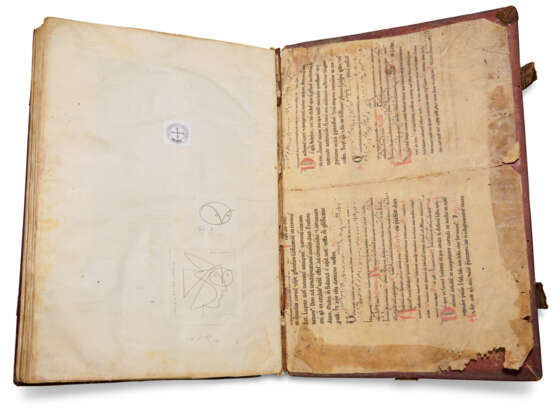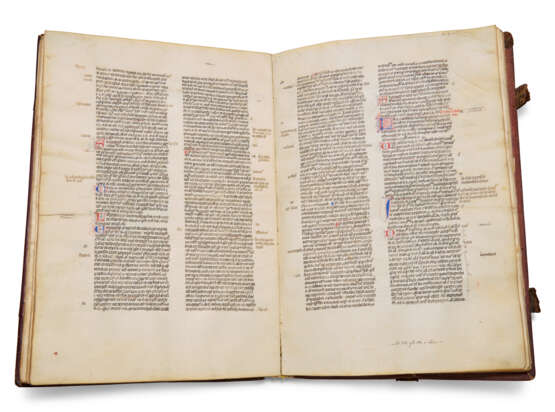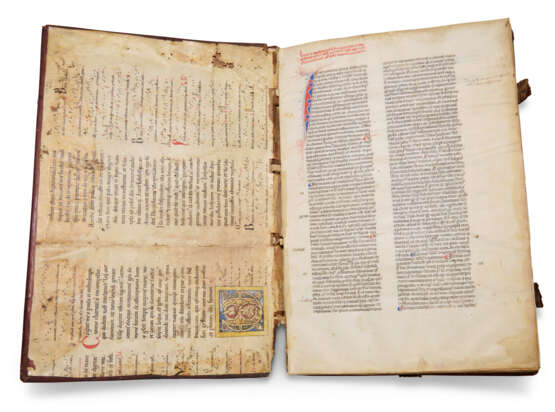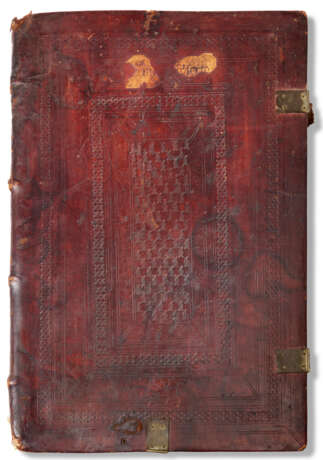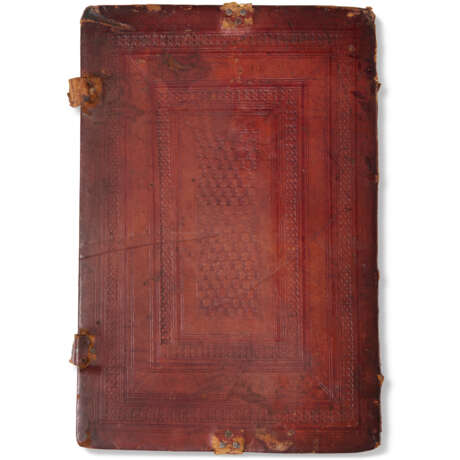ID 1214844
Лот 21 | The Ludwig-Getty Jean le Moine
Оценочная стоимость
£ 50 000 – 80 000
Johannes Monacus (Jean le Moine) (d. 1313), Apparatus sexti libri decretalium, in Latin, decorated manuscript on vellum [Southern France, mid 14th century]
A very handsomely written copy of an uncommon text, in a rare example of a lavishly tooled Spanish medieval binding, formerly in the Ludwig and Getty Museum collections.
405 × 275mm. 108 leaves, including a final blank leaf, foliated in the lower gutter corner, complete, collation; 1–1010, 118, catchwords throughout, leaf signatures in ink in most gatherings, written in 2 columns of 60 lines, written space: 290 × 180mm, decorated with large puzzle initials in blue and red with penwork flourishing in purple and red for the beginnings of the books, and similar smaller initials for the beginnings of the chapters (minor stains at the edges of leaves, but generally in fine condition throughout).
Binding:
15th-century Spanish binding of brown morocco over oak boards, richly blind-tooled with concentric frames around a rectangular central area (two of the tools are found on the binding of Madrid, Biblioteca nacional, MS 9748, Virt. II-14, a manuscript dated 1462; see H. Thomas, Early Spanish Bookbindings, XI–XV Centuries (1939), pp.18-19 and pl. XXV), sewn on 4 cords, the pastedowns made from two Spanish breviaries, with the remains of four clasps, the front cover with the remains of a 15th-century paper title label: ‘[...]es [...]o mo[nachus] s(upe)r sexto’ (the tail of the spine defective, the joints cracking, clasp-straps missing, but generally in fine condition). Fitted box.
Provenance:
(1) Script and decoration suggest that the manuscript was produced in southern France; Montpellier, as the leading centre of legal studies in France, is therefore the most likely place of origin.
(2) In Spain by the mid-15th century, when bound.
(3) Lucien Scheler (1902–1999), writer, poet, publisher, and bookseller, of Paris; acquired in 1960 by:
(4) H.P. Kraus, Inc., New York: offered in their Catalogue 100: Thirty-Five Manuscripts [1962], no 14, with full-page plate, priced $2,000.
(5) Peter (1925–1996) and Irene (1927–2010) Ludwig, of Aachen and Cologne, with their bookplates by Pablo Picasso (f.108v), their MS XIV 4 (fully described in Anton von Euw and Joachim M. Plotzek, Die Handschriften der Sammlung Ludwig, IV (Cologne, 1985), pp.56-58 with full-page colour plate); the collection sold en bloc in 1983 to:
(6) The J. Paul Getty Museum; deaccessioned with a number of other unilluminated manuscripts in 1997, to:
(7) Jörn Günther Antiquariat, Hamburg; subsequently with Sam Fogg, London, before passing back to H.P. Kraus: in their Catalogue 216: Varia [2001], no 162, acquired in September 2002 by:
(8) The Schøyen Collection, MS 5151.
Content:
The text begins with a preface, preceded by a rubric identifying the author: ‘Incipit apparatus libri decretatlium compositus apud Iohanne monachi sancte Romane ecclesie presbitero cardinali tituli sanctorum Marcellini & Petri. In dei nomine amen, secundum philosophum scire est rem per causam cognoscere […]’, ff.1–2; followed by the main text, ‘Sacrosancte. Hec epistola dividitur in quatuor partes […]’, Book I, ff.2–47; Book II, ff.47–62; Book III, ff.62–77; Book IV, ff.77–78; and Book V, ff.78–107v; ending with a rubric like that on f.1. The subdivisions of the text are described at length by von Euw and Plotzek, 1985 (see above).
There is no obvious explanation for the pages of text laid out in lozenge and hourglass patterns.
The text has been carefully corrected, sometimes rectifying substantial omissions. At f.2v, for example, in the upper left corner, is a marginal note stating that about 12 lines have been omitted (‘Hic deficiunt .xij. linee vel circa’); in the lower margin of the same page the missing text is added, where it occupies only 6 lines, because it is written across the page, and not in two columns. Similarly, on f.4 is a marginal note that half a column is missing (‘Hic deficit medietas [co]lumpne’), and the addition fills most of the lower margin.
The pastedowns are formed of incomplete bifolia from two elegantly written 12th- or early 13th-century Spanish decorated manuscript noted breviaries, each with staveless music: that at the front written in two columns of at least 31 lines, with a large decorated initial ‘V’ for ‘Vidi speciosam sicut columbam ascendentem’ (I saw the fair one rising like a dove) for the feast of the Assumption of the Virgin; that at the back written in a single column of at least 23 lines, including parts of the text for Thursdays and Saturdays throughout the year.
From the middle of the 12th century, the primary textbook of Canon Law was the Decretum of Gratian; this was superseded a century later by the Decretals of Gregory IX, arranged in five books. At the end of the century this was supplemented by a sixth book, the so-called Liber Sextus, or simply Sext, of Pope Boniface VIII. The present manuscript is a commentary on the Sext, composed in 1301 by Jean le Moine or Lemoine (d.1313), who had been made a cardinal by Pope Celestine V in 1294. It was well received and came to be known as the Glosa Aurea, circulating in two forms: either as a gloss surrounding the main text of the Sext, in a layout like that found in lot 18, or on its own, as in the present manuscript. Lemoine is credited with having established the legal principle of the presumption of innocence.
| Место происхождения: | Западная Европа, Франция, Европа |
|---|---|
| Категория аукционного дома: | Манускрипты Средневековья и Ренессанса, Книги и рукописи |
| Место происхождения: | Западная Европа, Франция, Европа |
|---|---|
| Категория аукционного дома: | Манускрипты Средневековья и Ренессанса, Книги и рукописи |
| Адрес торгов |
CHRISTIE'S 8 King Street, St. James's SW1Y 6QT London Великобритания | |
|---|---|---|
| Предосмотр |
| |
| Телефон | +44 (0)20 7839 9060 | |
| Комиссия | see on Website | |
| Условия использования | Условия использования |
